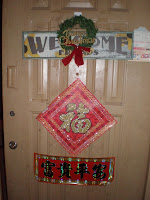Monday, December 13, 2010
Language and Culture
Thursday, December 9, 2010
Holiday Fun


Wednesday, November 24, 2010
I love my job

Monday, November 15, 2010
Tiger Leaping Gorge


Saturday, November 6, 2010
Missouri Comes To Yunnan
The Missouri team with our government partners

Our view from where we were digging, just beautiful
While we were in the village, we took a break from digging one afternoon to visit an orange plantation and tea factory in the nearby town. The owner of the orange plantation was extremely gracious, he took us out amongst the trees and told us to eat until we were full, which we did. All of us took home quite a few oranges and had sticky hands from all the peeling we did in the field.
After the orange plantation, we headed to the tea factory where we were served pu’erh tea and were given a tour of the factory where they press and ship out tea to all over the world, including America. I was amazed to see tea leaves that were decades old. Tea is similar to wine in the idea that with age it gets better. We were taken through the process of when the tea leaves are picked from the plant, laid out to dry, pressed into bricks or discs, roasted or fermented, packaged and shipped out. China sure does tea differently than America and it was very interesting to see the process in its entirety.
The group gave the owner of the orange plantation a Kansas City baseball hat
Another afternoon in the village we visited a local school. The school had about 30 students, grades 1-3. The school had students from a few different neighboring villages and we spotted a few children we knew from the village we were digging in. We stood in front of the classroom and told them our names and where we were from. I practiced my chinese and asked the students for their names and ages. I was just as timid as they were when spotlighted to use a new and different language. We then sang the song “Head, Shoulders, Knees and Toes” which got a real big laugh out of them.
All of the students and their teachers

The group from Missouri had brought lots of great toys to give to the children including coloring books, crayons, jump ropes, bubbles and stickers. All of the children had huge grins on their faces and by the end of the afternoon were not so shy and afraid of the silly foreigners.
The end of our trip concluded with a bon fire/dance party with the villagers. Its a time for them to come together, have a feast (they told us they wanted to kill a cow for the dinner, which we tried to talk them out of), dance, sing and enjoy each others company. We danced under the moonlight around the fire putting a nice end onto a wonderful trip.
The group digging Just give me a hoe and some dirt and I'll give you a trench
Tuesday, October 26, 2010
Jiaozi and Tea







Saturday, October 23, 2010
Photo Journal











Monday, October 11, 2010
Luang Prabang, Laos
October 1st is a nationally recognized holiday in China called National Day where the majority of people have off work for an entire week. This week is usually spent traveling around China, seeing new sights or going home to spend time with family. According to China Daily, they expected 210 million people to be traveling around China during this week. 210 million people! My roommate and I looked at each other once we heard that and confirmed that we were getting out of China for National Day.
We looked at our options and decided to head to Laos since it borders Yunnan and we could take a bus straight there. So the night before National Day, September 30th, we hopped on a sleeper bus and headed to Laos. 26 hours later, we arrived dazed and confused in Luang Prabang, Laos’ second largest city.
Over the next four days we enjoyed a relaxful vacation filled with kayaking, swimming, hiking, eating and lounging. We kayaked to one of Luang Prabang's famous waterfalls where we swam in the cool, refreshing water and enjoyed the sun. Myself and two other friends went zip-lining through the forest above the waterfalls. I saw some great scenery and got my thrills from flying through the air high above the trees. Another day, we took a boat ride down the Mekong River to explore some caves with ancient Buddhist statues inside. The Mekong River is a widely known river within southeast Asia, as it flows through China, Thailand, Laos and Cambodia.



Luang Prabang is also well known for their Buddhist wats (temples). There are over 30 around the city, making them unavoidable. One morning we got up early to observe the monks collecting their morning alms and food. The monks spend their days meditating and taking care of the temple, they do not have time to buy and cook their own food, so the town’s people provide their only source of food in the morning. The majority of these monks are boys aging from 10-25 who stay in the monastery for only a short time.
Laos was reopened to tourism in 1989 and Luang Prabang was deemed a UNESCO World Heritage sight in 1995, thus leaving the city mostly bus/car free and preserving its French provincial architecture. Laos is known for its laid back attitude and we easily fell into the mood while we were there. We enjoyed French baguets and freshly made fruit shakes, a much enjoyed break from Chinese food.
Our bus ride back to Kunming was only about 20 hours. We returned safetly with many souvenirs and a new stamp in our passports.

































